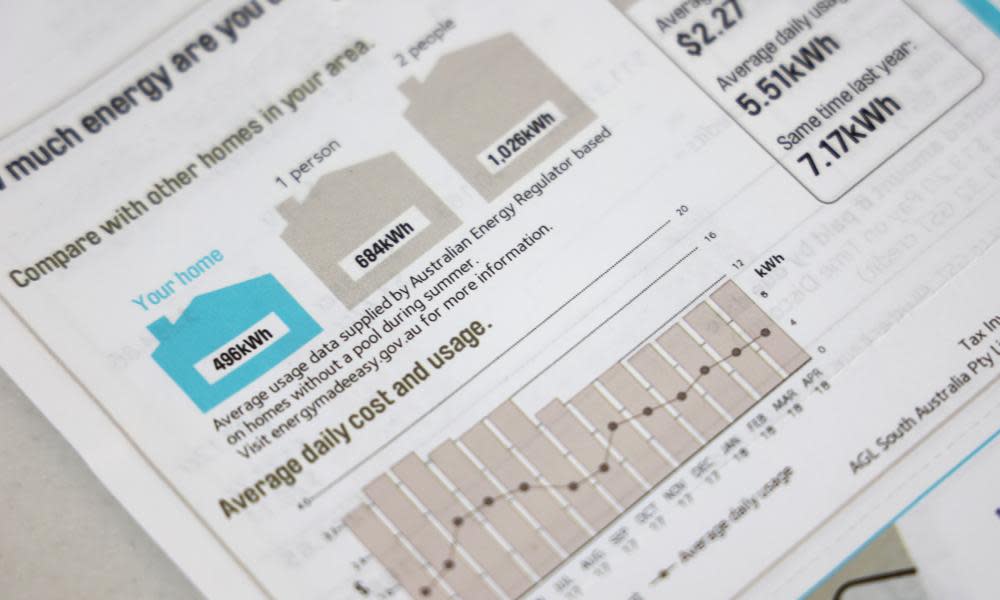Electricity prices to rise by up to a quarter in parts of Australia after energy regulator issues market default decision

Electricity prices will rise by up to a quarter in July in some states after the Australian Energy Regulator issued its decision on the default market offers that set the baseline for retailers.
But the AER says this is about the half the hike that might have happened without government intervention.
The offers, which cover New South Wales, South Australia and south-east Queensland, indicate prices will rise between 19.6% and 24.9% for residents, similar to the draft levels announced in March. Victoria also announced a 25% rise to its default offer.
Sign up for Guardian Australia’s free morning and afternoon email newsletters for your daily news roundup
Clare Savage, AER’s chair, told ABC radio that the increases could have reached 50% without the federal imposition of price caps on gas and black coal last December that helped lower the wholesale component of electricity prices.
For NSW, residential customers without controlled load will see price increases of 20.8% to 21.4%, the regulator said, noting the rise exceeded the forecast inflation rate by as much 15.1 percentage points. Those with controlled load will see price increases of 19.6% to 24.9%.
Residential customers in south-east Queensland face increases of about 21.5% for customers without controlled load and 20.5% for customers with controlled loads. Those in South Australia without controlled load will see price rises of about 23.9%, or slightly more than the 22.5% for those with controlled load.
Related: Energy rebates: who will receive them and how much will bills fall under Labor’s budget measure?
Small business owners will be spared some of the worst of the rises, with those in NSW covered by Ausgrid to see prices jump 14.7% while those plugged into SA power 28.9%.
Residents with controlled load have separately metered tariffs used for appliances such as electric hot water storage systems, pool pumps or underfloor heating. The changes don’t affect feed-in tariffs paid to owners of solar panels who export excess power to the grid, whose payments depend on their retailer.
The regulator said the default market offers provide “an electricity price safety net that protects consumers from unjustifiably high prices” and apply to household and small business customers on standard retail plans.
Wholesale energy costs, which account for about a third to half of final bills, continue to be “the predominant driver of increased retail electricity prices”, the AER said. State and federal bill relief measures will take some of the sting out of the increases.
“We know households and small businesses continue to face cost-of-living pressures on many fronts, and that’s why it’s important the DMO provides a safety net for those who might not have shopped around for a better power deal,” Savage said.
“In setting the DMO price this year we have sought to protect consumers from unjustifiably high prices and at the same time allow retailers to offer consumers better deals than their standard plans.”
Related: Shop around and turn off appliances: ways to beat Australia’s energy price hikes
The Albanese government, which came to office promising household power prices would fall by $275 on average by 2025, said the AER had forecast increased tariffs of 40-50% late last year.
“In the longer term, we are getting more renewables in the grid through Rewiring the Nation and the Capacity Investment Scheme, because the cheapest form of energy is firmed renewable energy – and this will take pressure off bills and help shield Australians from volatile international energy prices,” Chris Bowen, the minister for climate change and energy, said in a statement.
The treasurer, Jim Chalmers, noted the Coalition had hid the power price increases last year by ordering the regulator to delay the announcement until after the election.
“It’s clear that our energy intervention has been successful in easing power price rises,” Chalmers said.
The Energy Consumers Australia’s interim chief executive, Jacqueline Crawshaw, said the higher default offers followed double-digit increases in the current year and were “another blow for consumers”.
Crawshaw said the federal budget’s energy bill relief package would counter the shock for millions of eligible households and small businesses but it was clear consumers needed additional support.
For Victorians, the higher offer adds $352 to the average residential power bill and $752 for small business customers. The final reading was $74-$126 less than proposed in the Essential Services Commission’s draft decision.
Marcus Crudden, an executive director at the ESC, said the trimmed increase was because of thinner retail margins, lower final network tariffs from the AER and changes to the wholesale electricity allowance.
“Stakeholders did raise deep concerns about the retail energy margin at the time of the draft, so we’ve reduced it from 5.7 to 5.3%, taking about $10 off the bill,” he said, adding that he expected prices had peaked.
The premier, Daniel Andrews, said 1.4 million Victorians had applied for the power saving bonus, with 40% receiving a better deal.
“[Energy companies] don’t ring you to tell you you’re paying too much. You’ve got to ... make sure you’ve got the best deal,” he told reporters in Dandenong.
Consumers can review offers and concession at www.energymadeeasy.gov.au and check rebate and concession eligibility at the ECA’s advice hub and Victorian Energy Compare.

 Yahoo News
Yahoo News 
